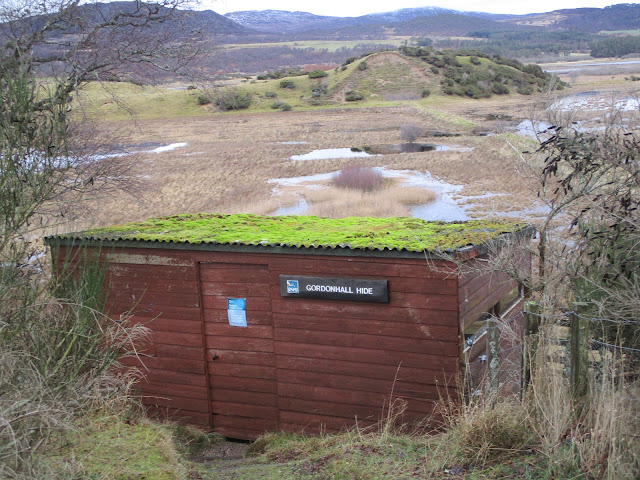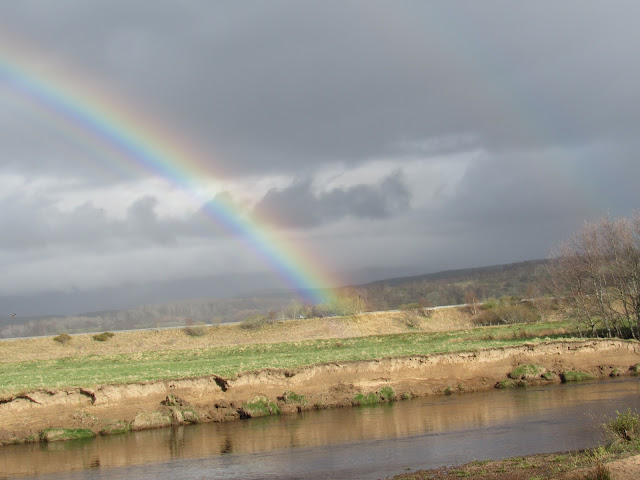WHAT happens if you gather together 31 frontline birders, equip them with high-quality optical equipment, then locate them in prime habitat in the Scottish Highlands?
Between April 28 and May 2 - the period of the visit - what fantastic species are they absolutely certain to see? And in what quantities?
Here is the result - and, be warned, it does not make for pretty reading.
Crossbill: 0
Ptarmigan: 0
Capercaillie: 0
Golden eagle: 0
White-tailed eagle: 0
Black-throated diver: 0
Red-throated diver: 0
Dotterel: 0
Chaffinch: 7,497,542-plus!
Something not quite right here. What could it have been?
a) Poor bird detection skills?
b) Birds present - but laughing at us from the treetops?
c) Unfortunate timing - were we a week, maybe a fortnight, too early?
.JPG) |
| Rare and very shy birds - how true! |
Some of Scotland's celebrity species had definitely gone awol, but, as the old birding saying goes, never have 'target' birds - the quest is more important than the discovery.
What is more, some very good birds were, indeed, seen, including (albeit briefly), for a few of our party that most delightful of north-of-the-border species, the crested tit.
Credit it, too, goes to the ospreys which were nesting, true to half-a-century's worth of tradition, at our first excursion destination, RSPB Abernethy/Loch Garten.
 |
| The ospreys at Loch Garten never fail to deliver |
They were in very good form, not least when they took to their air to see off the unwelcome attentions of a marauding carrion crow
 |
| Ever-reliable, an osprey surveys the scenery |
Nearby, three tree pipits put in an unexpected appearance, while goldeneye and common sandpiper were conspicuous at nearby Loch Mallachie.
 |
| This handsome drake goldeneye was spotted on Loch Mallachie |
Atop Cairngorm, the ptarmigan, dotterel and eagles may have proved elusive, but snow buntings, in breeding plumage, put on a spectacular show
Lower down, near where the funicular railways starts its upward journey, two ring ouzels - a male and a female - showed well.
The next morning - one filled with wind, low cloud and drizzle - no divers were to be seen on Lochindorb, but the surrounding moorland was full of red grouse, wheatears and meadow pipits.
 |
| What's Terry Whalin pointing to at Lochindorb? It's a red grouse |
Meanwhile, both in Grangetown-on-Spey and in Aviemore, the trees and shrubs were alive with singing willow warblers and blackcaps.
In the fields all around, oystercatchers, curlews, grey lag geese, thrushes and rabbits were aplenty, plus the occasional hare and roe deer.
Base for the holiday - laid on for LBC by Goole-based Cairngorm Travel - was the excellent Duke Of Gordon hotel whose friendly staff provided hospitality in the best Scottish traditions, not least with their succession of sumptuous breakfasts and evening meals.
On one night we were even led in by a piper - surely a first for a birding holiday?
There are surely few better places in the Highlands than the Duke as a centre for all-round wildlife-watching.
Just over two miles away from the hotel lies another wildlife reserve, RSPB Insh Marshes, famous in winter for its population of duck, waders and whooper swans and, later in summer, for its nesting sandpipers, flycatchers, redstarts and wood warblers.
 |
| One of the hides at Insh Marshes |
Within three minutes' walk from the hotel, two pairs of dippers provided enchanting close-up views for members of our party.
Just another couple of minutes' walk away, a pair of goosander were swimming on the Spey while twittering sand martins were flitting hither and thither from their 40- hole colony in a sandbank.
 |
| A sandbank along the Spey was home to a colony of sand martins |
And what was that silhouette of a sleek mammal that scampered past? Was it just a stoat - or could it have been a pine martin or an otter?
What of the woodlands up the slope immediately behind the hotel?
Magnificent habitat where easily to be found were great spotted woodpeckers, mistle thrushes, treecreepers, siskins and more, most notably cavorting red squirrels.
 |
| Treecreeper - a species frequently to be seen in the woods and forests |
To provide interest, we had two free prize draws - one on the outward journey from Lincolnshire, one on the return.
 |
| Book winner - Sam Mather with his friend, Elysha McBride |
Finally, a word for Paul, Cairngorm Travel's entertaining and very obliging coach driver.
He couldn't find us any eagles, but that was not for want of trying.
He took us to all the right habitats including some remote spots where, understandably, a coach had probably never previously been seen!
All in all, as one of our party put it, "a very enjoyable experience".
 |
| The Duke of Gordon Hotel as seen from the side |
 |
| Happy to be birding in the Cairngorms |
 |
| Robins were often to be seen pecking about near the entrance to the hotel |
 |
| Spot the dipper - it's on the branch - a species frequently seen where the waters were shallow and fast-moving |
.JPG) |
| Where are we going next? Group members prepare to board the coach for the next excursion |
 |
| Not as common as rabbits, but hares were often to be seen |
 |
| Great tits and coal tits were common everywhere. Less so crested tits with only a few sightings |
.JPG) |
| Congratulations to Sandra Harlow - winner of the other book. She is pictured with husband Stuart and sister Christine |
 |
| Last but not least, Paul - our entertaining and ever-obliging coach driver |
.JPG)




No comments:
Post a Comment